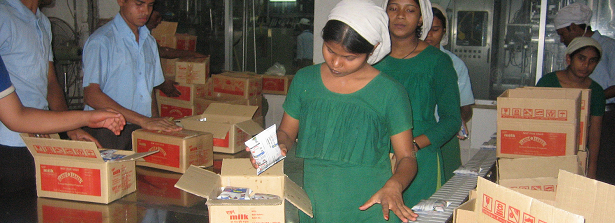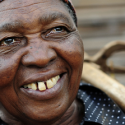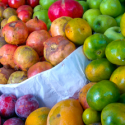First AIM article in a series: Scaling up Inclusive Business

Introduction
The Amsterdam Initiative against Malnutrition (AIM) brings different stakeholders together to improve food and nutrition security through a broad portfolio of projects. These projects are executed throughout the entire food value chain with a focus on the consumer. Since 2009, AIM has grown to include 30 stakeholder-partners who explore innovative and sustainable solutions to address malnutrition, using a market-based approach and new social business models that are financially sustainable.
One key challenge of AIM’s projects is to reach appropriate scale to deliver large impact to and with low-income groups. And to develop appropriate business propositions for that purpose. This article illustrates the main challenges that businesses face while scaling their operations with low-income groups or the Base of the Pyramid (BoP). It will address the following questions:
- What does ‘scale’ of an inclusive business mean in the food and nutrition sector?
- What are the key challenges for reaching scale at the Base of the Pyramid (BoP)?
The article is also meant as a base for further discussion, developed by the BoP Innovation Center in cooperation with SNV, AIM and Nyenrode University. Two particular cases are presented at the bottom of the article to foster such exchange. Among the discussion questions are the following:
- What were the key success factors in initiatives that succeeded in reaching scale?
- Did the increased involvement of BoP customers, distributors and producers, also lead to a proportional increase in social impact, e.g. a higher income, or an improved nutrition situation?
Based on the discussion and a further in-depth analysis of some of the aspects presented below, the concept paper will be extended later on.
Reactions are welcome using the ‘Contributions’ function at the bottom of this page.
Base of Pyramid (BoP)
The Base of the Pyramid refers to the more than four billion people who earn less than US$ 8 per day (PPP). They mainly live in Asia, Africa and South America1. This term and the thinking behind it have positioned the poor in a completely different light. They are no longer seen as just the ‘hungry masses’, but rather as value-demanding consumers, resilient and creative entrepreneurs, producers, business partners and innovators. Given the sheer size of the group and growth trends of these countries, the market potential for BoP is enormous. The World Bank estimates BoP markets’ global size at $20 billion for water-related projects, $433 billion for energy and $2895 billion for household food needs. These sectors affect billions of low-income people and represent a combined market value of over $ 5 trillion2. Moreover, there is growth in BoP markets. The fastest growing economies of the world are in developing markets where a majority of the BoP resides. For the period 2001-2010, six of the ten fastest growing economies worldwide were in Africa and the other four were in Asia.
The private sector, being SMEs or multinational corporations alike, shows a growing interest in this market segment – developing products and services based on the four A’s (4A): affordability, accessibility, availability and acceptability. These business strategies have more chance to be successful if they are inclusive – in other words involving and engaging the local BoP communities, the so-called ‘inclusive business’.
Companies like d.light, which provides affordable renewable energy for low-income people; M-PESA, the most successful mobile money transfer system for the unbanked in Kenya; or JITA, which uses an innovative way of reaching the unreachable in Bangladesh, have managed to reach scale in BoP markets. However, this is only a limited number of examples.
The meaning of scale in BoP markets
Scale for an inclusive business is linked to the increase in the number of customers served, the number of low-income people embedded in the business, the increase of revenue of these people and to the progress on (social) impact targets. Let us look at the different dimensions of scaling inclusive businesses, i.e. the different ways in which more poor people can be engaged (more) effectively:
BoP as customers
The nature of a given sector widely influences the nature of the notion of scale of an inclusive business. In the ICT sector, by 2012, a stock of about 17 million M-PESA accounts had been registered in Kenya (see en.wikipedia.org/wiki/M-Pesa ). In the food sector, Renata Limited, a producer of human and animal health products in Bangladesh, and BRAC, a large grassroots non-governmental organization with a network of rural health volunteers have teamed up to produce and sell Pushtikona (‘grains of nutrition’). These are high quality, affordable sachets of vitamin and mineral powder to be added to home-cooked complementary foods for infants and young children aged 6 to 24 months. Close to 1.3 million sachets of Pushtikona are sold door to door per month, reaching approximately 200,000 infants of this age group per month.
BoP embedded in the business, e.g. as distributor
People who earn less than US$ 8 per day also work as entrepreneurs or business partners, and may play a key role in the distribution of nutritious products.
For JITA in Bangladesh, Aparajitas are sales ladies who interact with customers either door-to-door, with a mobile stall or at household yard gatherings. As of today, 7,650 Aparajitas sell products for nutrition, hygiene & better-living and household energy of well-known brands at the village level.
In West Africa today, Fan Milk offers unique frozen dairy products, juice and juice drinks to a total population of more than 200 million people inhabiting seven West African countries. The biggest enabler of Fan Milk’s growth was their distribution system. They are also a pioneer in the development of sales and distribution systems. Bicycle vendors were introduced in the early days in Ghana and today consumers can still see thousands of Fan Milk vendors on their bicycles all over West Africa. 31,000 of these vendors are currently working for Fan Milk.
BoP as producer
Poor producers, such as small-scale farmers, may be actively engaged in value chains of relevance to tackle malnutrition.
Tanga Fresh Ltd. is a joint venture between a Tanzanian farmers association (TDCU) and investors. It offers a coordinated dairy value chain of milk collection, processing and marketing combined with growth opportunities offered to smallholders through heifer availability and cattle credit, known as ‘the Tanga Model.’ In 2011, Tanga Fresh Ltd. sourced its milk from 4,063 smallholders that produce around 38,000 L/day. The company is market leader in Tanzania.
Looking at the above three dimensions, it is clear that there is a variety of options for the engagement of the BoP (e.g., as consumers, distributors, producers) in food and other value chains. This implies that the perspectives for scaling up an inclusive business are also quite different, also with regard to the numbers of people that can be reached. Having one million of BoP customers for M-PESA is a starting point, while engaging over 7,000 women in Bangladesh to distribute BoP products is already a significant achievement for JITA. However, while these companies presented previously have scaled, these are currently the exception rather than the norm. Inclusive businesses face a number of challenges that limit their scale including the evaluation of the scale itself.
Different scaling challenges per level
The challenges of scaling in BoP markets can be described over the following four levels. Distinguishing these may help developing effective solutions at the appropriate level:
- The BoP level
- The company level
- The value chain level
- The ecosystem level
At the BoP level, the lack of product awareness is a major impediment to scale. BoP consumers are risk averse and cautious buyers. Without awareness of the value proposition of BoP products or BoP engagement in inclusive business, sales or impact remain low. Increased awareness could unlock market demand. In addition, the BoP remains a largely unknown target group. The market information that companies are able to secure with regard to the BoP is superficial and often driven by a basic understanding of BoP needs and not by real market aspiration. The consequence is that inadequate services and products are developed, which results in low market penetration and limited progress on social impact. For instance what are the aspirations of BoP populations in Sub-Saharan Africa to buy nutritious food?
At the company level, especially in large corporations, there is often no innovation culture that would foster the development of inclusive businesses, and leadership attitudes may be variable with regards to BoP initiatives. In addition, expectations of return are based on traditional key performance indicators which do not apply in the BoP context. Finally, inclusive business requires a set of skills (e.g., brokering partnership with NGOs) not always available at the company level. Engagement of smallholder farmers for instance is a lengthy process that companies like Tanga Fresh have mastered.
At the value chain level, one of the main challenges is the incapacity to build large distribution networks due to constraints in the operating environment (physical dispersion of population, poor infrastructure). Except for innovative products, margins for inclusive business are often low and require high volume transactions and a large reach. FanMilk or JITA have succeeded but how can these models be replicated to sell nutritious food products for instance?
At the ecosystem level, there is a lack of inclusive public policies addressing bottlenecks of the business environment that would encourage the rise of inclusive business. Additionally, in terms of financial access, the impact investor sector is emerging but is still conservative in its choice of investment and is challenged to value informality or innovative inclusive business models. Finally, as inclusive business is an emerging industry, a pool of new actors especially intermediaries (e.g., the BoP Innovation center) between companies, non-for-profit organizations and academics have to be better organized and supported.
To scale inclusive business effectively, a systemic approach is needed incorporating solutions at the different levels. Even the most appropriate products or a successful business model engaging smallholder farmers cannot scale if distribution systems are not in place and adequate finance is not available. A scaling approach is systemic by intervening at the BoP, company, value chain and ecosystem levels but also by engaging businesses, governments, NGOs and academics in building a conducive environment for inclusive business to scale.
Let us work together to find adequate solutions and scale inclusive business at the BoP.
Discussion
This article is also meant as a base for further discussion. Two particular cases, briefly referred to in the text above, are presented in more detail below to foster such exchange. Among the discussion questions are the following:
- What were the key success factors in initiatives that succeeded in reaching scale?
- Did the increased involvement of BoP customers, distributors and producers, also lead to a proportional increase in social impact, e.g. a higher income, or an improved nutrition situation?
Reactions are welcome using the ‘Contributions’ function at the bottom of this page.
Case Value Chain: Delivering nutritious food at the BoP in Bangladesh
JITA is a joint venture of CARE (a Bangladesh based NGO) and Danone.communities. It is a distributor company, which provides rural distribution services to a number of well-known brands, to make their produce (including nutritious products) available at rural village level and at an affordable price. JITA has built an effective, efficient and low-cost distribution channel with large reach into rural low-income households. Sales ladies interact with customers, either door-to-door (households), in mobile stalls (village square, at school) or at household yard gatherings. They are trained in selling various products and on business, accounting and communication, as well as on community mobilization. To sustain marketing efforts, Jita employs ‘activation officers’. These officers actively create awareness on food & nutrition and hygiene to boost sales. They carry small battery powered projectors and attend rural events and markets. Other marketing methods include mobile shows through branded cars.
Sub-questions for discussion:
- Can this model to solve value chain issues be replicated in other countries or regions?
- Are there other successful models to distribute at scale to the BoP?
Case BoP/Company: Sourcing and selling milk products in Tanzania
Tanga Fresh Ltd. is a medium scale dairy company from Northern Tanzania. It is a joint venture between a Tanzanian farmers association, the Tanga Dairy Cooperative Union (TDCU), and a group of investors. Tanga Fresh Ltd. operates a coordinated dairy value chain of milk collection, processing and marketing, combined with growth opportunities offered to smallholders through heifer availability and cattle credit, known as the ‘Tanga Model’. In 2011, Tanga Fresh Ltd. sourced its milk from 4,063 smallholders that produce around 38,000 L/day. The company is market leader in Tanzania and sells several low- to medium-cost dairy products, mainly fresh milk and mtindi (sour milk), in Tanga and Dar-es- Salaam. The main innovation in the Tanga Model is the creation of rural Milk Collection Centers (MCC) that act as a one-stop shop for farmers by providing animal feed, medicine and advice for farmers, all on the same premises.
Sub-questions for discussion:
- What skills has the Tanga Fresh team developed and used to reach this market penetration and interact with smallholder farmers?
- How does the enabling environment, like government policy or financial regulation, influence Tanga Fresh?








The article lays out the key determinants for success i.e. business, social and environmental. Market success is defined by the fit of the business offering and the consumer needs and consumer wants (both are important). This requires an in-depth consumer insight and a viable business approach to be merged into a winning proposition. It is the mix that defines the market and AIM appears to live that. Good!